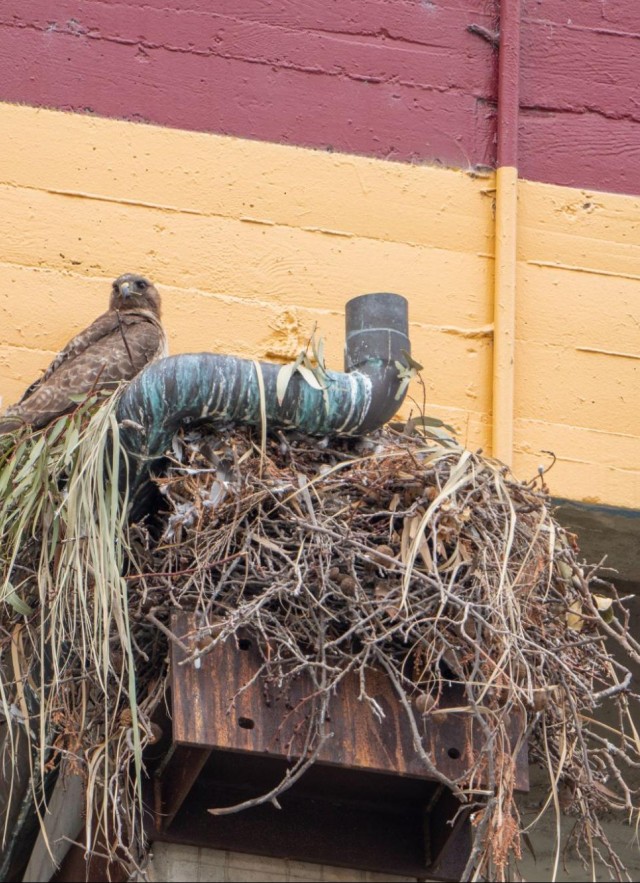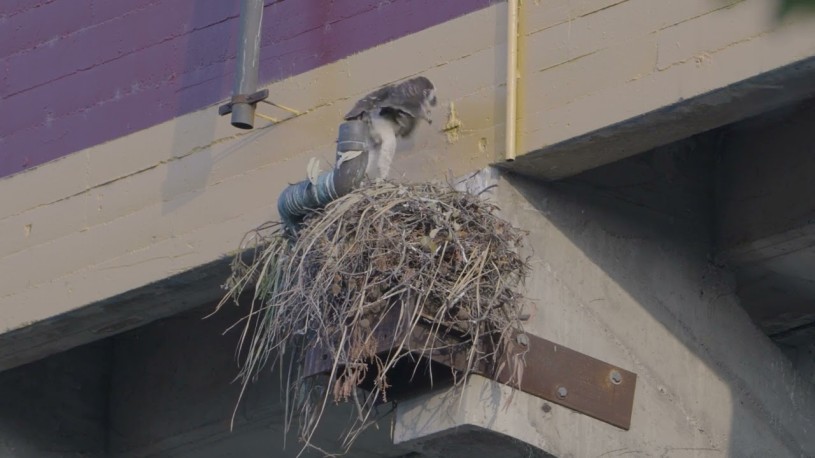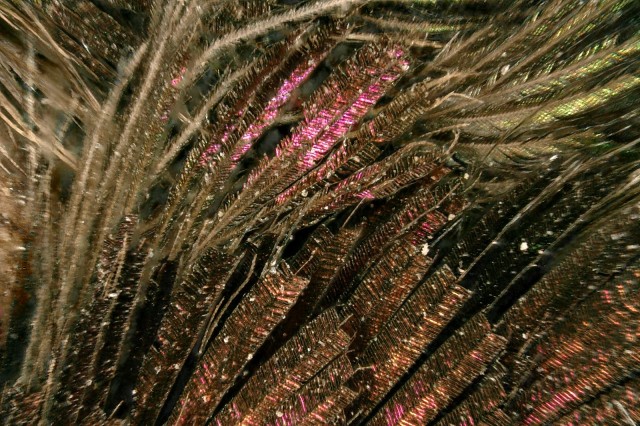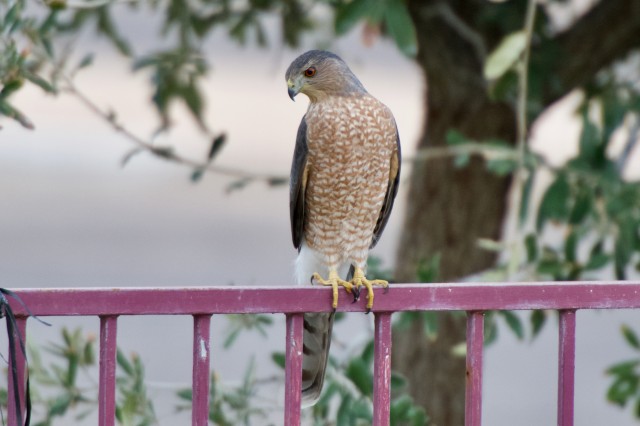The museum will be closed Thursday, December 25 for the Christmas holiday. We will reopen Friday, December 26.

Published August 7, 2024
Imagine this.
Early spring. You’re at the Natural History Museum’s Nature Gardens, and you start to see poppies blooming, so many cool bees pollinating beautiful wildflowers, and tons of birds singing, making their presence known. Spring has sprung! You're on your lunch break catching up with your friend Vijay, one of the coolest data scientists you know, and you’re sharing stories and talking about urban wildlife.
Vijay mentions that one of the Educators here at NHM saw red-tailed hawks building a nest on the L.A. Memorial Coliseum. And sure enough, as we spoke, a glorious hawk appeared with branches in its talons. I was so excited! I told Vijay, “Sorry, but I really have to see this,” and ran out of the gardens to look for the nest, and—boom! Smack in the middle of Exposition Park, attached to the Coliseum, is a red-tailed hawk nest the size of a small washing machine made of hundreds of sticks.

Photo by Moses Aubrey

Photo by Moses Aubrey

Photo by Moses Aubrey

Photo by Moses Aubrey
1 of 1
Photo by Moses Aubrey
Photo by Moses Aubrey
Photo by Moses Aubrey
Photo by Moses Aubrey
I took some pictures of the nest and spent the rest of my lunch break there. Then I headed back to work, where I was even more excited to spread the news about the nest with the Ornithology Department, the Mammalogy Department, the UNLAB cohort, and anyone with ears!

Photo by Moses Aubrey

Photo by Moses Aubrey
1 of 1
Photo by Moses Aubrey
Photo by Moses Aubrey
What’s a red-tailed hawk? Well, I’m glad you asked. Red-tailed hawks are raptors, or birds of prey, opportunistic hunters with a wide diet. Their prey ranges from small rodents, rabbits, and bats to praying mantises, lizards, and much more, and they prefer to hunt in open fields. They live throughout most of North America in highly urbanized areas, like Exposition Park and along the 110 Freeway, as well as in rural areas. They’re named after their tail, which surprisingly isn't always red. As the hawks mature, their tail will turn red during the start of their second year. Interestingly, when you imagine the iconic, piercing call of a bald eagle, that’s actually a red-tailed hawk that you’re thinking of.

Over the next few months I was able to witness incredible hawk behaviors right here in Exposition Park. One of those behaviors was the opportunity to see the nesting pair’s courtship display. Typically, mid-day they would fly over the Museum and soar right above USC. As they gained elevation, they would lower their talons and spiral around one another. This would help strengthen their bond, and they continued to do so well after they had laid their eggs.
Unfortunately, they often gained the attention of crows and ravens that were not too happy about having hawks in their territory. #birddrama The crows and ravens would dive-bomb the hawks, swooping down in an attempt to scare them off. Sometimes the hawks would just fly away. Other times, the hawks would fight back, by dive-bombing the crows and ravens. Seeing those aerial maneuvers above USC was so much fun to watch!

April was approaching and I was not optimistic that the hawks were going to have any chicks. I’d heard from Nurit Katz, outreach coordinator of the L.A. Raptor Study, that last year the hawks had been unsuccessful in raising young. Now they were continuing to mate and do their courtship display, but because the nest was high up on the Coliseum, it was hard to tell if there were any baby hawks. But sure enough, in May, there were two chicks, looking so funny in their fluffy down feathers and prehistoric dinosaur-esque look. As time passed, they outgrew the nest and attempted to fly.

Photo by Moses Aubrey

Photo by Moses Aubrey
1 of 1
Photo by Moses Aubrey
Photo by Moses Aubrey
It still blows my mind that this all happened in Exposition Park, where tens of thousands of people from all over the world pass this nest unknowingly every day. I’m sure the hawks are not the biggest fans of loud football games and concerts at the Coliseum, but that’s just life in Los Angeles. These hawks are so incredibly resilient and never cease to amaze me!

In addition to red-tailed hawks, there are several other raptors that call urban Greater L.A. home, such as great horned owls, American kestrels, Cooper's hawks, and barn owls, among others. And raptors are the tip of the iceberg: in Exposition Park alone, woodpeckers are foraging for insects in tree bark, territorial butterflies, vibrant green bees, the cutest little furry jumping spiders (genus Habronattus) with their complex and elaborate courtship displays, and so much more.

Photo by Moses Aubrey
Great horned owl

Photo by Moses Aubrey
American kestrel

Photo by Moses Aubrey
Adult Cooper's hawk

Photo by Moses Aubrey
Juvenile Cooper's hawk

Photo by Moses Aubrey
Barn owl
1 of 1
Great horned owl
Photo by Moses Aubrey
American kestrel
Photo by Moses Aubrey
Adult Cooper's hawk
Photo by Moses Aubrey
Juvenile Cooper's hawk
Photo by Moses Aubrey
Barn owl
Photo by Moses Aubrey
Los Angeles is part of a biodiversity hotspot spanning from the Baja California peninsula to southern Oregon, which means its species diversity is incredibly high, and there are plants and animals found here and nowhere else in the world like the giant sequoia or Nuttall's woodpecker to name a few. Unfortunately, many of these plants and animals are nearing extinction due to habitat loss through development, climate change, and a general lack of public awareness. With free apps like iNaturalist, you can document all the plants, animals, and fungi in your own neighborhood or wherever you happen to be or travel to. I’ve been able to learn so much about L.A.’s wildlife by documenting every species I encounter, whether on the beach, while hiking, taking a stroll at a park, or even in my apartment. I’d like to encourage you to use iNaturalist too. If you want to learn how to use it, check out the video I made. I hope you take a few moments of your day to go outside and connect with nature. You just might be surprised by what you find. :)
Interested in learning more about raptors in L.A.? Consider volunteering for the L.A. Raptor Study and help researchers and scientists learn about raptor populations in L.A.! Applications are open now!

